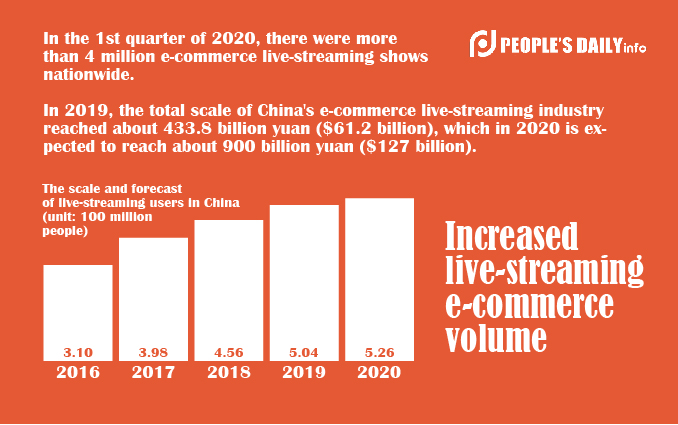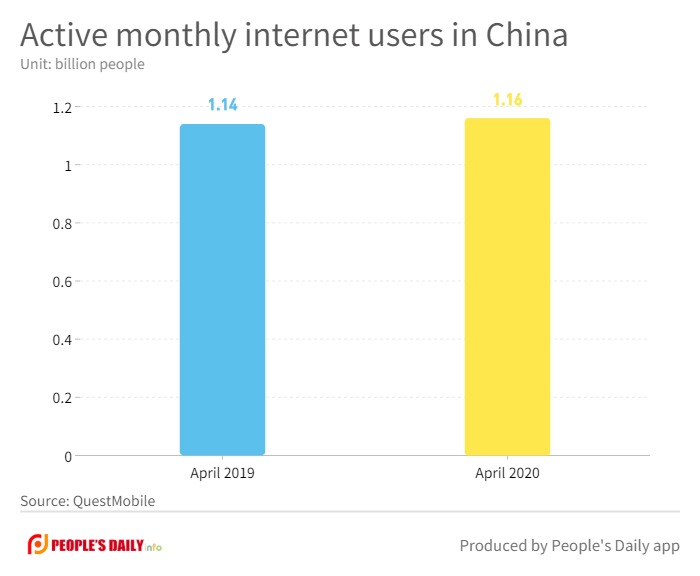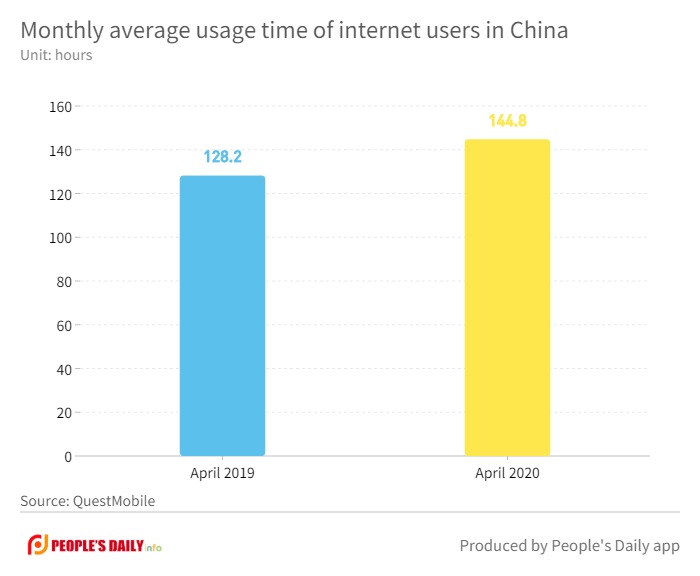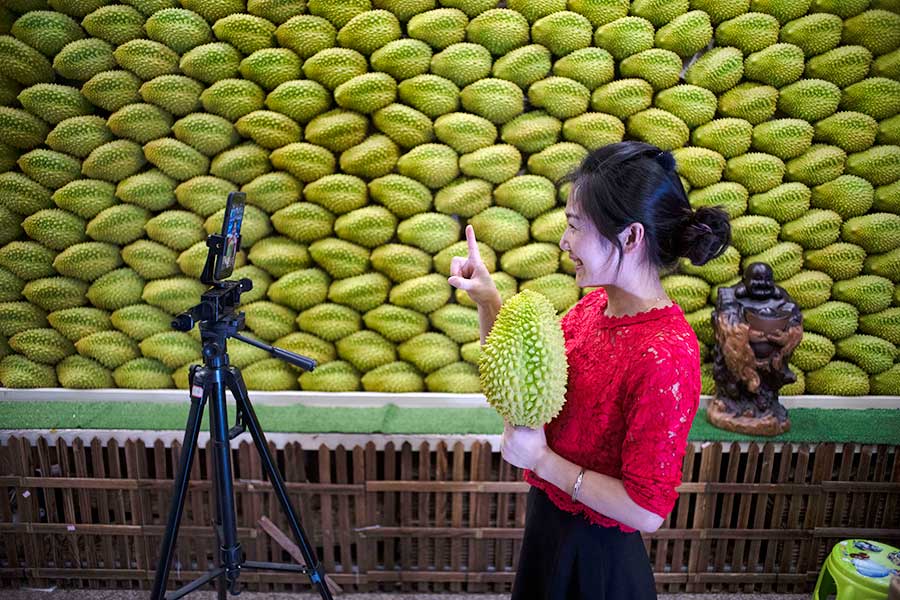
Tian Yumiao, a tea plantation staff, presents the scenery of tea gardens via live stream in Hefeng County, central China's Hubei Province, April 8, 2020. (Photo/Xinhua)
“Three! Two! One!”
The countdown ends, but the oranges all sold out 10 minutes ago.
That’s 460,000 yuan ($65,000) in sales, to thousands of online customers, for the county of Zigui in Yichang, Central China’s Hubei Province.
It’s just another sale, on just another day, for Lu Hui, the County Party Secretary and host of the online sale.
Lu is just another anchorman in China, promoting their brands or selling home-grown produce to online buyers at potential bargain prices.

Increased live-streaming e-commerce volume in China (Infographics: People's Daily app)
The year 2019 saw 433.8 billion yuan in total sales and explosive growth in e-commerce live-streaming.
That fat figure will more than double this year, most observers agree.
A popular anchor can negotiate deals with brands for his or her followers and in two clicks, a buyer can snap up a discount using the link posted with the broadcast.

Various reasons for Chinese customers to shop through live-streaming sites (Infographics: People's Daily app)
Bargains pump up viewership and sales. More sales mean better discounts and a nice little virtuous circle for anchors and buyers.
Only a few years ago, live-streaming meant interactive gaming or quirky performance pieces.
But when the marketing men noticed the far-reaching influence of live-streaming, an e-commerce sales market was born.
Video/People's Daily
Live-streaming on e-commerce platforms popped up in 2016. Competition among anchors was fierce right from the start.
Three years on, the undisputed queen of e-sales is Viya Huang.
Huang ruled supreme with billions in sales in 2019 during the annual “Double Eleven” Singles' Day shopping blitz.
In 2020, Huang even sold a rocket. For 40 million yuan.
The Kuaizhou, or Speedy Vessel, can enter low-Earth orbit and was manufactured by ExPace, a subsidiary of China Aerospace Science and Industry Corporation, as one of their commercial launch vehicles.
The buyer was Changguang Satellite Technology Company.
Beauty influencer Li Jiaqi, the “lipstick king,” has achieved fame for catchphrases such as “Buy it buy it buy it!” and the occasional “Oh my god!” in English.

Frequency of Chinese customers shopping on live-streaming sites (Infographics: People's Daily app)
Showbiz entertainers and internet celebrities were not slow to notice live-streaming offers them not only broader exposure but also potentially hefty profits.
Entrepreneur Luo Yonghao makes 110 million yuan in sales on his April 1 broadcast debut.
The e-commerce live-streaming industry accelerated like a Kuaizhou to 504 million users in 2019, reaching ever-more remote regions and markets of the motherland.
Anchors need little training to sell goods live online and their numbers have mushroomed too to meet the skyrocketing demand.
Video/People's Daily
“In front of you is the screen. How can you transfer the delicious feeling to the audience? Now let’s learn the expressions of live-streaming,” says Zhang Qi, teacher of an e-commerce video training class for farmers in the southern province of Hainan.
Through live-streaming, vendors of agricultural produce can vault the great wall between urban and rural China.
By visually demonstrating the quality of their products and services on the sites, farmers and workshop owners can promote and sell products directly to customers, at minimal cost.
An 80-year-old grandmother went viral for her apricots.
Cui Shuxia’s earthy wit, and love of red apricots, earned her an overseas audience.
“Grandma’s apricots must be as sweet as her!” posted one YouTube user.
Rural e-commerce businesses today number more than 13 million, according to the latest Ministry of Commerce statistics.
In 2019, online retail sales of agricultural produce were 397.5 billion yuan, an increase of 27% year-on-year, boosting the incomes of more than 3 million farmers.

Strengthened Chinese customers' live-streaming usage (Infographics: People's Daily app)
An old internet meme “Everything can be live-streamed” became reality in 2020, dubbed “the year of the live-streaming industry” by many an economic observer.
The arrival of COVID-19 has only boosted the engines of the rocketing live-streaming industry into the stratosphere of even broader adoption on a variety of platforms.
Commerce, agriculture, education and medical treatment anchors have busied themselves live-streaming through the lockdown.

China had 1.16 billion active monthly internet users in April 2020, according to QuestMobile, a 1.8 percent increase on April 2019.

If the number of users appears to have reached a saturation point, the usage time is growing: monthly average use was 144.8 hours, a 12.9 percent hike, in April 2020.
In the space of a few years, live-streaming has evolved from nerd fringe theater to mainstream corporate marketing, from a niche entertainment tool to the commercial empowerment of the masses.
Successful live-streaming hinges on meritocracy, equality and innovation, say observers.

He Xiaoman promotes Vietnamese durian via live streaming. She started the business in 2018. (Photo /China Daily)
Behind the lens, every live-streamer is fighting for our attention.
Retailers sell their goods online. Medical experts share epidemic advice. Farmers connect with hungry buyers of their produce.
Live-streaming sites offer a diverse choice of live windows on the real China, reflecting dynamic walks of life from all across the country.
Source: People's Daily, China Daily
Editor: Lv Yun